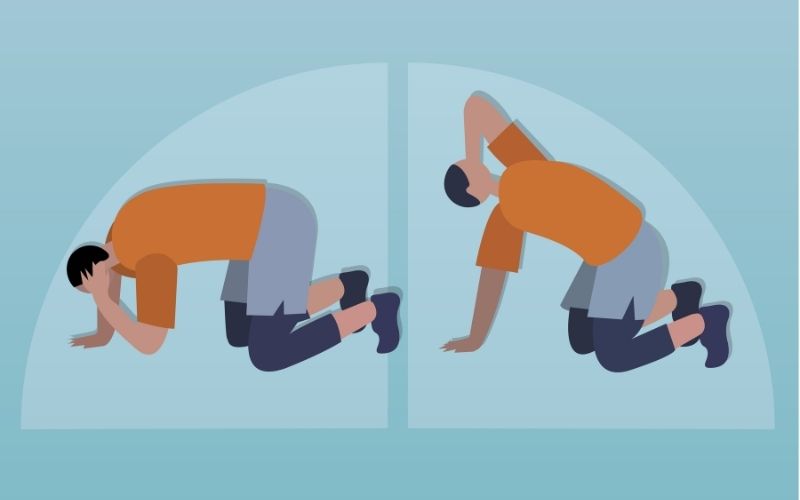How To Properly Do The T-Spine Rotation To Relieve Tension In Your Back, Neck, And Shoulders

Many of us, especially as we age, hold the majority of our daily stress within our neck, back, and shoulders.
This stress can build up over time and turn into pain if left untreated.
Thankfully, there is a simple stretch that can be done daily to alleviate any stress or pain that is present throughout these areas, the T-Spine Rotation stretch.
Below we will discuss what the T-Spine Rotation stretch is, how to properly utilize the stretch, and the benefits of doing so.
What is the T-Spine rotation stretch?
Your thoracic spine, T-Spine, encompasses the longest region of the spine from the base of the neck down through your abdomen.
It’s a complex part of your body due to it being the only spinal region directly connected to the rib cage while also maintaining the positioning of the cervical spine above it and the lumbar spine below.
With these connections, it can affect most other regions if not taken care of properly creating stiffness in the neck and shoulders or tightness within the upper back.
By stretching this area you’re not only able to feel immediate relief from any tightness or discomfort that is occurring, but you’ll also be slightly realigning back to a natural posture over time.
How to properly utilize the T-Spine rotation stretch?
The key to receiving the most benefits from your stretch is to ensure that you have the proper form. To properly utilize the T-Spine Rotation stretch:
- Start by getting on your hands and knees with your shoulders, wrists, and elbows in line and your knees directly under your hips.
- Keeping your knees steady and your hips level, place your right hand behind your head.
- Strengthen your core as you would during a plank.
- Begin to rotate your middle and upper back down towards the floor to where your right elbow is pointing down and towards the left.
- After curling down, switch direction to raise your right elbow towards the ceiling while allowing your head and upper back to twist upwards and to the right as far as possible.
- Repeat multiple times on the right side and then switch to the left side.
Once you have your form properly established, you want to make sure that you are able to stick with a comfortable range of motion to where you’re able to open your chest as you twist and move slowly with control to where you can feel this twist within your middle and upper back. If at any point you feel this stretch affecting your lower back, be sure to stop the movement and realign your posture as that would indicate your form is off.
To realign your movement, ensure that your core is strengthened by keeping your abs tight throughout the exercise and by making sure that your supporting arm’s shoulder, elbow, and wrist are in line.
The benefits of the T-Spine rotation stretch
As you begin utilizing this stretch you will come to find a plethora of benefits that begin throughout your body including:
- Increased Shoulder Mobility. Studies have shown that low thoracic spine mobility is associated with poor shoulder mobility meaning that if you’re feeling tightness within your shoulders or have experienced any immobility issues they can start the path to alleviation through the T-Spine Rotation stretch.
- Improved Posture. Many of us sit hunched over most of the day typing on computers or being on our phones which can lead to thoracic kyphosis. When thoracic kyphosis occurs the muscles in your spine are stretched pulling your shoulders and chest forward causing poor posture. When you’re twisting during the T-Spine Rotation stretch you’re opening up your pectoral muscles to prevent poor posture from occurring.
- Reduce Damage from Sitting. Along with poor posture from sitting hunched over, there is damage that occurs for those who sit for seven or more hours a day or those who partake in less than 150 minutes of activity per week which can lead to limited thoracic mobility. As you increase your mobility, you also reduce any damage that has been done.
- Prevention of Pain. If your thoracic spine isn’t able to be as mobile as it should be, other parts of your body such as your lumbar spine begin to pick up the slack which can cause pain in your lower back or move up the body to your neck and shoulders. By opening your chest through this stretch you’re able to ease the tension in these areas and provide the mobility needed to prevent any pain from being felt throughout the body.
Conclusion
It is clear that your thoracic spine, as a mobile joint, is one that factors into many other areas of the body, especially those around it within our neck, shoulders, and lower back.
By properly stretching this area you’re able to alleviate pain and stiffness, increase your mobility, and reduce any damage from being sedentary that may have occurred.





